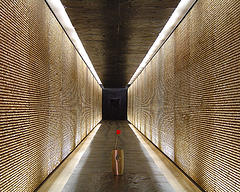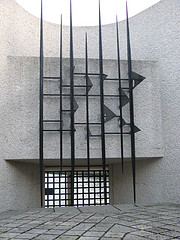

Square de I'lle de France
Tel. 01 46 33 87 56
Subway: Cite
Open: 10am- 6pm Tue- Sun

Mémorial des Martyrs de la Déportation is a museum of Deportation of 200,000 French men and women of all ages during World War II. It contains the names of all concentration camps and earth that was brought from these camps.
Mémorial des Martyrs de la Déportation located in
the 4th district of Paris, at the eastern tip of Ile de la Cité
below the square of Ile-de-France. It was commissioned by the
Network of Remembrance which donated to the State on February 29,
1964. The project, realized by the architect Georges-Henri
Pingusson, it was inaugurated on April 12, 1962 by General de
Gaulle, President of the Republic. To the visitor approaching, the
Memorial first appears as a kind of whitish stone bunker. It is down
a relatively narrow, steep staircase with uneven steps that it
enters the monument. All the construction is made of concrete
covered with a hammered coating where gravel from various regions of
France are integrated, all giving the impression of a raw natural
stone.
From a triangular courtyard, a crypt with narrow passages and dimly
lit unfolds in the mass of the monument. A long corridor protected
by a grid has on its walls 200 000 glass sticks symbolizing the
countless victims of the deportation in the Nazi camps, at the
entrance of this corridor is a tomb that contains the remains of a
dead unknown deportee at the Natzweiler-Struthof camp and
transferred here on 10 April 1962. The triangular courtyard opens
towards the river by a horizontal embrasure obstructed by angular
bars. The visitor is almost at the level of the Seine and the only
views to the outside are through the embrasure towards the running
water of the river or vertically towards the sky where the clouds
pass. After the descent of the steps, this contributes to creating a
strange sensation where the visitor is as outside the world that
continues to exist and to move outside.
To the right and to the left two diverticula comprise, inserted in
triangular niches, urns containing earth coming from the different
camps as well as ashes brought back from the cremation ovens. On the
walls are inscribed extracts of poems or quotes from Robert Desnos,
Paul Eluard, Louis Aragon, Vercors, Antoine de Saint-Exupery,
Jean-Augustin Maydieu and Jean-Paul Sartre. Above, accessible only
on request, several rooms present an exhibition.
Located in the 4th arrondissement of Paris, at the eastern tip of the
Ile de la Cité below the Square de l'Île-de-France, the memorial was
commissioned on the initiative of the Réseau du Souvenir, which donated
it to the State on February 29, 1964.
The project, carried out by
the architect Georges-Henri Pingusson, was inaugurated on April 12, 1962
by General de Gaulle, President of the Republic.
Description
At first glance, the memorial appears as a kind of whitish stone bunker.
You enter the monument by descending a relatively narrow, steep
staircase with uneven steps. The entire construction is made of concrete
covered with a hammered coating in which gravel from various regions of
France is integrated, the whole resembling a rough natural stone.
From a triangular courtyard, a crypt with narrow and dimly lit
passages unfolds in the mass of the monument. A long corridor protected
by a grid presents on its walls 200,000 glass rods symbolizing the
countless victims of deportation in the Nazi camps, at the entrance to
this corridor is a tomb which contains the mortal remains of an unknown
deportee, exhumed from the National Necropolis of Struthof and
transferred here on April 10, 1962.
The triangular courtyard
opens towards the Seine through a horizontal doorway obstructed by
angular bars. Visitors are virtually at river level and the only views
out are through the doorway to the running water of the river or
vertically up to the sky where the clouds pass. After descending the
steps, this architecture seeks to create a strange sensation where the
visitor is as if outside the world which continues to exist and move
outside.
On the right and on the left, two diverticula contain,
inserted in triangular niches, urns containing earth coming from the
various camps as well as ashes brought back from the crematorium ovens.
On the walls are inscribed extracts from poems or quotations from Robert
Desnos, Paul Éluard, Louis Aragon, Vercors, Antoine de Saint-Exupéry,
Jean-Augustin Maydieu and Jean-Paul Sartre.
Above, accessible
only on request, several rooms present an exhibition.
The restoration of the building, completed in 2015, resulted in work to integrate the networks and lighting, compatible with the minimalism and stripping of the site. Skins of the concretes and colors of the decorations have been restored. The course, deliberately difficult in order to evoke the sufferings of the deportees, has been enhanced but also made easier for people with reduced mobility. Upstream of the building, a new reception has brought together the toilets, the dressing room and the security and surveillance post. This operation wanted by the Ministry of Defense was directed by Christophe Batard, chief architect of historical monuments.
The memorial is free to access every day. A team of cultural mediators welcome visitors, and free guided tours take place on Saturdays at 3 p.m. Every last Sunday of April, during the National Day of Remembrance of the Deportation, a ceremony takes place there.